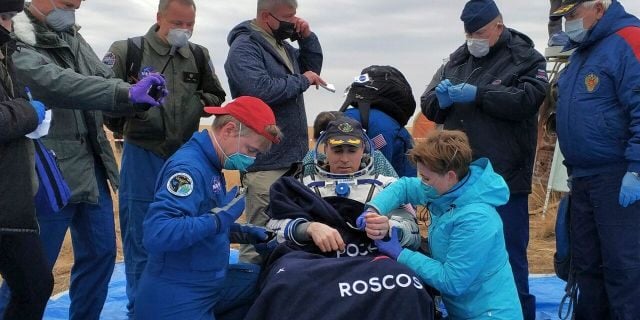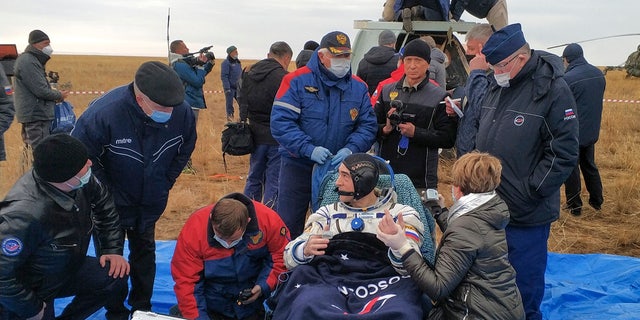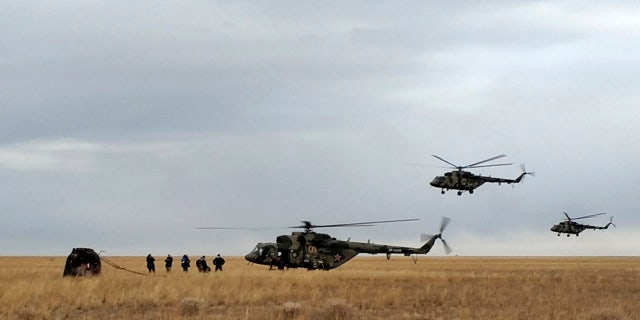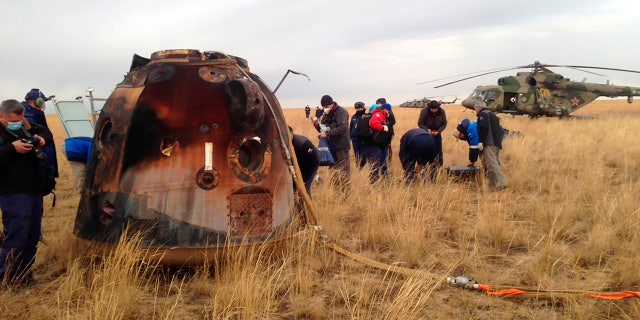Science
NASA astronaut Chris Cassidy, Russian counterparts return safely to Earth from space station

|
|
MOSCOW – A trio of space travelers safely returned to Earth on Thursday after a six-month mission on the International Space Station.
The Soyuz MS-16 capsule carrying NASA astronaut Chris Cassidy, and Roscosmos’ Anatoly Ivanishin and Ivan Vagner landed on the steppes of Kazakhstan southeast of the town of Dzhezkazgan at 7:54 a.m. (2:54 GMT) Thursday.
After a brief medical checkup, the three will be taken by helicopters to Dzhezkazgan from where they will depart home.
Cassidy will board a NASA plane back to Houston, while Vagner and Ivanishin will fly home to Star City, Russia.
In this photo released by Rosaviatsiya, NASA astronaut Chris Cassidy sits in a chair shortly after the landing near town of Dzhezkazgan, Kazakhstan, Thursday, Oct. 22, 2020.
(Rosaviatsiya via AP)
The crew smiled as they talked to masked members of the recovery team, and NASA and Roscosmos reported that they were in good condition.


In this photo released by Roscosmos Space Agency, NASA astronaut Chris Cassidy sits in a chair shortly after landing near town of Dzhezkazgan, Kazakhstan, Thursday, Oct. 22, 2020.
(Roscosmos Space Agency, via AP)
As part of additional precautions due to the coronavirus, the rescue team members meeting the crew were tested for the virus and the number of people involved in the recovery effort was limited.
Cassidy, Ivanishin and Vagner spent 196 days in orbit, having arrived at the station on April 9. They left behind NASA’s Kate Rubins and Roscosmos’ Sergey Ryzhikov and Sergey Kud-Sverchkov, who arrived at the orbiting outpost a week ago for a six-month stay.


In this photo released by Roscosmos Space Agency, Roscosmos’ cosmonauts Anatoly Ivanishin, left, and Ivan Vagner sit in fchairs shortly after the landing near town of Dzhezkazgan, Kazakhstan, Thursday, Oct. 22, 2020.
(Roscosmos Space Agency via AP)
Cassidy, returning from his third space mission, has now spent a total of 378 days in space, the fifth highest among U.S. astronauts.
While serving as the station’s commander, Cassidy welcomed SpaceX Demo-2 crew Robert Behnken and Douglas Hurley, the first NASA astronauts to launch to the space station on an American spacecraft from American soil since the retirement of the space shuttle fleet in 2011.


In this photo released by Rosaviatsiya, Roscosmos’ cosmonaut Anatoly Ivanishin sits in a chair shortly after the landing near town of Dzhezkazgan, Kazakhstan, Thursday, Oct. 22, 2020.
(Rosaviatsiya via AP)
Cassidy and Behnken completed four spacewalks for a total of 23 hours and 37 minutes, becoming two of only four U.S. astronauts to complete 10 spacewalks.


In this photo released by Rosaviatsiya, Russian rescue team helicopters land near a Russian Soyuz MS-16 capsule, left, landed near town of Dzhezkazgan, Kazakhstan, Thursday, Oct. 22, 2020. Rosaviatsiya via AP
(Rosaviatsiya via AP)
Before the crew’s departure, Russian cosmonauts were able to temporarily seal the air leak they tried to locate for several months. The small leak has posed no immediate danger to the station’s crew, and Roscosmos engineers have been working on a permanent seal.


The Soyuz MS-16 capsule carrying NASA astronaut Chris Cassidy, and Roscosmos’ Anatoly Ivanishin and Ivan Vagner landed on the steppes of Kazakhstan, southeast of the town of Dzhezkazgan, on Thursday.
(Roscosmos Space Agency via AP)
In November, Rubins, Ryzhikov and Kud-Sverchkov are expected to greet NASA’s SpaceX first operational Crew Dragon mission comprising NASA astronauts Mike Hopkins, Victor Glover and Shannon Walker, and Japan Aerospace Exploration Agency astronaut Soichi Noguchi.
Source: – Fox News
Science
Marine plankton could act as alert in mass extinction event: UVic researcher – Langley Advance Times


A University of Victoria micropaleontologist found that marine plankton may act as an early alert system before a mass extinction occurs.
With help from collaborators at the University of Bristol and Harvard, Andy Fraass’ newest paper in the Nature journal shows that after an analysis of fossil records showed that plankton community structures change before a mass extinction event.
“One of the major findings of the paper was how communities respond to climate events in the past depends on the previous climate,” Fraass said in a news release. “That means that we need to spend a lot more effort understanding recent communities, prior to industrialization. We need to work out what community structure looked like before human-caused climate change, and what has happened since, to do a better job at predicting what will happen in the future.”
According to the release, the fossil record is the most complete and extensive archive of biological changes available to science and by applying advanced computational analyses to the archive, researchers were able to detail the global community structure of the oceans dating back millions of years.
A key finding of the study was that during the “early eocene climatic optimum,” a geological era with sustained high global temperatures equivalent to today’s worst case global warming scenarios, marine plankton communities moved to higher latitudes and only the most specialized plankton remained near the equator, suggesting that the tropical temperatures prevented higher amounts of biodiversity.
“Considering that three billion people live in the tropics, the lack of biodiversity at higher temperatures is not great news,” paper co-leader Adam Woodhouse said in the release.
Next, the team plans to apply similar research methods to other marine plankton groups.
Read More: Global study, UVic researcher analyze how mammals responded during pandemic
Science
Scientists Say They Have Found New Evidence Of An Unknown Planet… – 2oceansvibe News


In the new work, scientists looked at a set of trans-Neptunian objects, or TNOs, which is the technical term for those objects that sit out at the edge of the solar system, beyond Neptune
The new work looked at those objects that have their movement made unstable because they interact with the orbit of Neptune. That instability meant they were harder to understand, so typically astronomers looking at a possible Planet Nine have avoided using them in their analysis.
Researchers instead looked towards those objects and tried to understand their movements. And, Dr Bogytin claimed, the best explanation is that they result from another, undiscovered planet.
The team carried out a host of simulations to understand how those objects’ orbits were affected by a variety of things, including the giant planets around them such as Neptune, the “Galactic tide” that comes from the Milky Way, and passing stars.
The best explanation was from the model that included Planet 9, however, Dr Bogytin said. They noted that there were other explanations for the behaviour of those objects – including the suggestion that other planets once influenced their orbit, but have since been removed – but claim that the theory of Planet 9 remains the best explanation.
A better understanding of the existence or not of Planet 9 will come when the Vera C Rubin Observatory is turned on, the authors note. The observatory is currently being built in Chile, and when it is turned on it will be able to scan the sky to understand the behaviour of those distant objects.
Planet Nine is theorised to have a mass about 10 times that of Earth and orbit about 20 times farther from the Sun on average than Neptune. It may take between 10,000 and 20,000 Earth years to make one full orbit around the Sun.
You may be tempted to ask how an entire planet could ‘hide’ in our solar system when we have zooming capabilities such as the new iPhone 15 has, but consider this: If Earth was the size of a marble, the edge of our solar system would be 11 kilometres away. That’s a lot of space to hide a planet.
[source:independent]
Science
Dragonfly: NASA Just Confirmed The Most Exciting Space Mission Of Your Lifetime – Forbes


NASA has confirmed that its exciting Dragonfly mission, which will fly a drone-like craft around Saturn’s largest moon, Titan, will cost $3.35 billion and launch in July 2028.
Titan is the only other world in the solar system other than Earth that has weather and liquid on the surface. It has an atmosphere, rain, lakes, oceans, shorelines, valleys, mountain ridges, mesas and dunes—and possibly the building blocks of life itself. It’s been described as both a utopia and as deranged because of its weird chemistry.
Set to reach Titan in 2034, the Dragonfly mission will last for two years once its lander arrives on the surface. During the mission, a rotorcraft will fly to a new location every Titan day (16 Earth days) to take samples of the giant moon’s prebiotic chemistry. Here’s what else it will do:
- Search for chemical biosignatures, past or present, from water-based life to that which might use liquid hydrocarbons.
- Investigate the moon’s active methane cycle.
- Explore the prebiotic chemistry in the atmosphere and on the surface.
Spectacular Mission
“Dragonfly is a spectacular science mission with broad community interest, and we are excited to take the next steps on this mission,” said Nicky Fox, associate administrator of the Science Mission Directorate at NASA Headquarters in Washington. “Exploring Titan will push the boundaries of what we can do with rotorcraft outside of Earth.”
It comes in the wake of the Mars Helicopter, nicknamed Ingenuity, which flew 72 times between April 2021 and its final flight in January 2023 despite only being expected to make up to five experimental test flights over 30 days. It just made its final downlink of data this week.
Dense Atmosphere
However, Titan is a completely different environment to Mars. Titan has a dense atmosphere on Titan, which will make buoyancy simple. Gravity on Titan is just 14% of the Earth’s. It sees just 1% of the sunlight received by Earth.
function loadConnatixScript(document)
if (!window.cnxel)
window.cnxel = ;
window.cnxel.cmd = [];
var iframe = document.createElement(‘iframe’);
iframe.style.display = ‘none’;
iframe.onload = function()
var iframeDoc = iframe.contentWindow.document;
var script = iframeDoc.createElement(‘script’);
script.src = ‘//cd.elements.video/player.js’ + ‘?cid=’ + ’62cec241-7d09-4462-afc2-f72f8d8ef40a’;
script.setAttribute(‘defer’, ‘1’);
script.setAttribute(‘type’, ‘text/javascript’);
iframeDoc.body.appendChild(script);
;
document.head.appendChild(iframe);
loadConnatixScript(document);
(function()
function createUniqueId()
return ‘xxxxxxxx-xxxx-4xxx-yxxx-xxxxxxxxxxxx’.replace(/[xy]/g, function(c) 0x8);
return v.toString(16);
);
const randId = createUniqueId();
document.getElementsByClassName(‘fbs-cnx’)[0].setAttribute(‘id’, randId);
document.getElementById(randId).removeAttribute(‘class’);
(new Image()).src = ‘https://capi.elements.video/tr/si?token=’ + ’44f947fb-a5ce-41f1-a4fc-78dcf31c262a’ + ‘&cid=’ + ’62cec241-7d09-4462-afc2-f72f8d8ef40a’;
cnxel.cmd.push(function ()
cnxel(
playerId: ’44f947fb-a5ce-41f1-a4fc-78dcf31c262a’,
playlistId: ‘aff7f449-8e5d-4c43-8dca-16dfb7dc05b9’,
).render(randId);
);
)();
The atmosphere is 98% nitrogen and 2% methane. Its seas and lakes are not water but liquid ethane and methane. The latter is gas in Titan’s atmosphere, but on its surface, it exists as a liquid in rain, snow, lakes, and ice on its surface.
COVID-Affected
Dragonfly was a victim of the pandemic. Slated to cost $1 billion when it was selected in 2019, it was meant to launch in 2026 and arrive in 2034 after an eight-year cruise phase. However, after delays due to COVID, NASA decided to compensate for the inevitable delayed launch by funding a heavy-lift launch vehicle to massively shorten the mission’s cruise phase.
The end result is that Dragonfly will take off two years later but arrive on schedule.
Previous Visit
Dragonfly won’t be the first time a robotic probe has visited Titan. As part of NASA’s landmark Cassini mission to Saturn between 2004 and 2017, a small probe called Huygens was despatched into Titan’s clouds on January 14, 2005. The resulting timelapse movie of its 2.5 hours descent—which heralded humanity’s first-ever (and only) views of Titan’s surface—is a must-see for space fans. It landed in an area of rounded blocks of ice, but on the way down, it saw ancient dry shorelines reminiscent of Earth as well as rivers of methane.
The announcement by NASA makes July 2028 a month worth circling for space fans, with a long-duration total solar eclipse set for July 22, 2028, in Australia and New Zealand.
Wishing you clear skies and wide eyes.
-



 Sports23 hours ago
Sports23 hours agoAuston Matthews denied 70th goal as depleted Leafs lose last regular-season game – Toronto Sun
-
Media3 hours ago
DJT Stock Rises. Trump Media CEO Alleges Potential Market Manipulation. – Barron's
-
Business22 hours ago
BC short-term rental rules take effect May 1 – CityNews Vancouver
-
Media6 hours ago
Trump Media alerts Nasdaq to potential market manipulation from 'naked' short selling of DJT stock – CNBC
-
Art21 hours ago
Collection of First Nations art stolen from Gordon Head home – Times Colonist
-



 Investment22 hours ago
Investment22 hours agoBenjamin Bergen: Why would anyone invest in Canada now? – National Post
-



 Tech23 hours ago
Tech23 hours ago'Kingdom Come: Deliverance II' Revealed In Epic New Trailer And It Looks Incredible – Forbes
-
Real eState24 hours ago
Sick of Your Blue State? These Real Estate Agents Have Just the Place for You. – The New York Times





